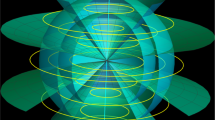Abstract
The aim of this paper is to get analytical solutions for the Free Maxwell Equations in Vacuum, using a cylindrical coordinate system, considering axial symmetry. The solutions represent steady-state electromagnetic field configurations in the form of closed magnetic surfaces where the magnetic field is time-dependent and tangential on these surfaces, and there is no electric field on them, and each of these closed surfaces includes a ring-like configuration of time-dependent electric field and tangential to the ring, without magnetic field on them. We analyse the temporal variation of the energy density together with the Poynting vector field, which describes the electromagnetic energy flow. We conclude that these configurations behave as standing wave solutions.











Similar content being viewed by others
Data Availability Statement
All data generated or analysed during this study are included in this published article (Appendix 1).
Notes
A polar vector changes its sign under the coordinate inversion transformation, but an axial one does not change.
References
A.E. Chubykalo, A.A. Espinoza, Unusual formations of the electromagnetic field in vacuum. J. Phys. A Math. Gen. 35, 8043–8053 (2002). https://doi.org/10.1088/0305-4470/35/38/307
D.A. Pérez-Carlos, A. Gutiérrez Rodríguez, A. Espinoza Garrido, Steady-state magnetic trap configurations for the axially symmetric free electromagnetic field in vacuum. Eur. Phys. J. Plus 138(2), 334 (2023). https://doi.org/10.1140/epjp/s13360-023-03945-y
T. Wiegelmann, T. Sakurai, Solar force-free magnetic fields. Living Rev. Sol. Phys. 18(1), 1–67 (2021). https://doi.org/10.1007/s41116-020-00027-4
J.J. Ali, How much energy can be stored in a three-dimensional force-free magnetic field? Astrophys. J. 375, 61–64 (1991). https://doi.org/10.1086/186088
H. Lamb, Hydrodynamics (Cambridge University Press, London, 1975)
V.I. Arnold, Khesin: Topologycal Methods in Hydrodynamics. International Series of Monographs on Physics, vol. 125 (Cambridge University Press, London, 1975)
R.P. Cameron, Monochromatic knots and other unusual electromagnetic disturbances: light localised in 3D. J. Opt. 2, 015024 (2018). https://doi.org/10.1088/2399-6528/aa9761
S. Fatholahzadeh, M. Jafarpour, S. Nasiri, Applying the Lagrange multiplier technique to reconstruct a force-free magnetic field. Astron. Astrophys. 676, 120 (2023). https://doi.org/10.1051/0004-6361/202243471
G.E. Marsh, A force-free magnetic field solution in toroidal coordinates. Phys. Plasmas 30(5), 052903 (2023). https://doi.org/10.1063/5.0146040
T. Fernholz, R. Gerritsma, R. Spreeuw, P. Krueger, Dynamically controlled toroidal and ring-shaped magnetic traps. Phys. Rev. A 75(6), 063406 (2007). https://doi.org/10.1103/PhysRevA.75.063406
D. Tharakkal, A.P. Snodin, G.R. Sarson, A. Shukurov, Cosmic rays and random magnetic traps. Phys. Rev. E 107(6), 065206 (2023). https://doi.org/10.1103/PhysRevE.107.065206
R.P. Cameron, F.C. Speirits, C.R. Gilson, L. Allen, S.M. Barnett, The azimuthal component of Poynting’s vector and the angular momentum of light. J. Opt. 17(12), 125610 (2015). https://doi.org/10.1088/2040-8978/17/12/125610
V. Cooray, G. Cooray, M. Rubinstein, F. Rachidi, Hints of the photonic nature of the electromagnetic fields in classical electrodynamics. J. Electromagn. Anal. Appl. 15(3), 25–42 (2023). https://doi.org/10.4236/jemaa.2023.153003
V. Onoochin, Violation of Gauss’s law in Schott’s solution. Indian J. Phys. 97(7), 2103–2108 (2023). https://doi.org/10.1007/s12648-023-02587-1
Acknowledgements
D. A. P. C. appreciates the post-doctoral stay founded by CONAHCYT. A. G. R. thank SNII (México).
Author information
Authors and Affiliations
Corresponding author
Appendix 1: Treatment of other solutions for the electromagnetic field in vacuum
Appendix 1: Treatment of other solutions for the electromagnetic field in vacuum
Consider case 1 of solutions (37) and (38) of section 2.1, where \(\xi =0\), \(AB\ne 0\). In this case, the vector \(\textbf{a}(\textbf{r})\) is
We use Eqs. (16) and (17) to separate spatial parts of the electric and magnetic fields. We obtain
and
Because we want the solutions to correspond again to standing waves, we need to apply the condition \(\textbf{e}(\textbf{r})\cdot \textbf{b}(\textbf{r})=0\) to these solutions. We have the two cases \(A=0\) and \(B=1\) or \(A=1\) and \(B=0\). For the former conditions
and
Therefore, the full solution for this case is
and
For the last conditions \(A=1\) and \(B=0\) we get
and
These results allow us to write the full solution for the second case as
and
These sets of solutions (73)–(74) and (77)–(78) diverge at the origin of coordinates as well as at infinity.
For the case 3, \(A=1\), \(B=0\), and \(\xi \ne 0\), we have
Analogous to the analysis in Sects. 3 and 4, we conclude that in this case, we obtain closed surfaces of the electric field in a hollow flat washer form, where the electric field is tangential over all the surfaces, and inside of each electric closed surface, there is only one magnetic field in the form of a ring.
The energy density for the solutions (79) and (80) is
where
Bot expressions (81) and (82) are different from the energy density given by Eqs. (64) and (65).
The Poyntig vector field is
This expression differs from Eq. (67). Expression (83) implies that the Poynting vector is zero on the electric surfaces and on the magnetic rings.
Both sets of solutions (46)–(47) and (79)–(80), which are convergent, can be taken, separately or combined, as a basis for constructing particular solutions of Maxwell’s equations with axial symmetry and convergent at the origin of coordinates and at infinity. However, the properties of these new solutions depend on the particular problem to be solved.
Rights and permissions
Springer Nature or its licensor (e.g. a society or other partner) holds exclusive rights to this article under a publishing agreement with the author(s) or other rightsholder(s); author self-archiving of the accepted manuscript version of this article is solely governed by the terms of such publishing agreement and applicable law.
About this article
Cite this article
Pérez-Carlos, D.A., Gutiérrez-Rodríguez, A. & Espinoza-Garrido, A. Standing wave solutions for the Free Maxwell Equations in Vacuum with azimuthal symmetry in cylindrical coordinates. Eur. Phys. J. Plus 138, 1148 (2023). https://doi.org/10.1140/epjp/s13360-023-04780-x
Received:
Accepted:
Published:
DOI: https://doi.org/10.1140/epjp/s13360-023-04780-x



